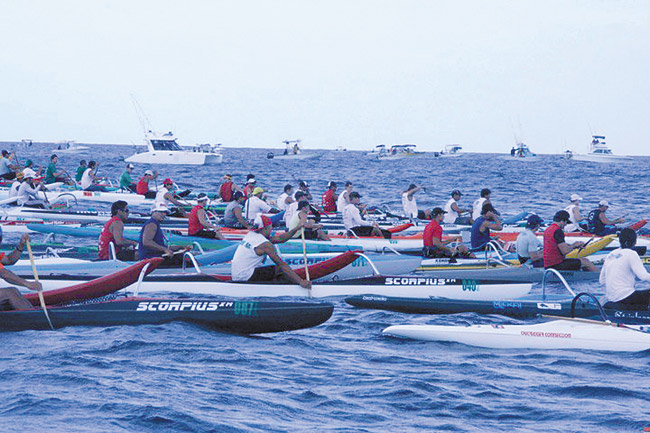A Busy Month For Canoe Paddlers
Hawaii’s canoe paddlers will be extremely busy in the months of May and June, with several major events happening over the next four weeks.
It all gets started Sunday (May 11), with the 25th annual Kahala Kaiwi Relay. Veteran paddler Walter Guild created the race back in 1990, making it the longest-running OC1 race. The relay format allows paddlers to come together from all over the world and be part of a “team” in what is usually a single-man sport.
mw-mizutani-050714-molokai
“It is a chance for OC1 paddlers to experience the channel with a partner, which cuts the paddling time in half, anywhere from two-and-a-half to three hours, on average, per paddler,” says race director Manny Kulukulualani. “This allows many paddlers a chance to paddle oneman canoe across the channel who may not want to race the entire distance on their own.”
Then before you can say, “paddles up,” hundreds of paddlers will line up May 18 for the Maui Jim Molokai Challenge & Surf-ski World Championships.
But there’s absolutely no time to rest – seven days later, May 25, Kulukulualani will host the Maui Jim Kaiwi Channel Solo OC1 Molokai World Championship.
“This often is considered the pinnacle of the OC1 paddling world, and it names OC1’s world champions,” says the 37-year-old paddler. “Unlike other sports, paddling doesn’t have the amateur and professional divisions to separate its athletes, so that means on race day you get all levels of paddlers competing at the same time in the world’s biggest open-ocean swells.”
And finally, June 7-8, an elite group of paddlers will compete in the Paddling Athletes Association Eono Hoe Umikumalua, a twoday race that takes paddlers from Maui to Molokai on day one, and Molokai to Oahu on day two.
“The first Eono race was in 2010, an iron-format from Molokai to Oahu,” explains Kulukulualani. “The challenge was to race without changing, and do it with canoes that lifted the 400-pound restriction and design specifications. Essentially, paddlers are racing to go as fast as possible, and the equipment used to achieve these speeds plays a critical role. The Eono challenges both athletes and builders to elevate the sport of canoe paddling.”
Kulukulualani is not only the race director for three of the four world-class events, but also one of the sport’s top competitors. He says organizing the events gives him great joy, even if it means less time in the water for his own training.
“I rely heavily on pursuing what I love, and another big part of it is learning to sacrifice things that most people would take for granted,” says the fiercely competitive Kulukulualani, who balances his professional career working in research and education in public health with his passion for paddling. “For myself, paddling is in the center, with the rest of my life evolving around it, not the other way around. There are times when paddling has to become play, but those are very seldom compared to the countless hours of training.”
And while it’s great to see familiar faces in the lineup on race morning, he says it’s more rewarding to see new faces in the crowd.
“It is definitely important for the sport to grow,” he says with excitement. “I think everyone who paddles is a little crazy, and I am pretty sure I’m no exception. I love to watch the sport progress. I get to watch young and old – all walks of life, from the least to the most experienced – come together at races and do what they love. I guess it’s entertaining to know that I’m not the only crazy one out there enduring a canoe race, what could be considered self-torture to many.
“What do they say? ‘Misery loves company’!”
You could call it a rewarding kind of misery.
rkmizutani@gmail.com






